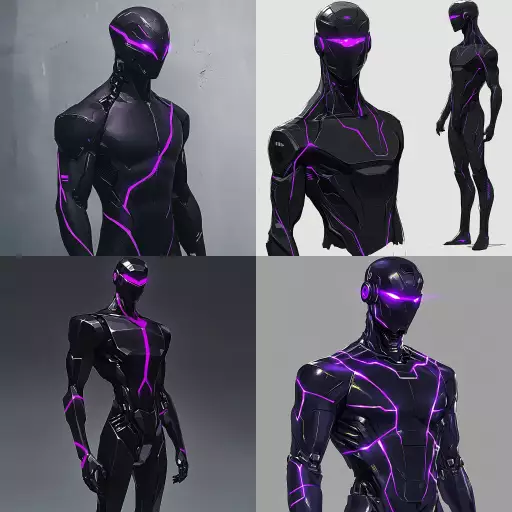Explore the Best AI Image Gallery

Pixelated Perceptions: AI Image Generation and the Evolving Design Landscape
The realm of design is undergoing a seismic shift, driven by the burgeoning power of artificial intelligence (AI). AI image generation tools, capable of producing stunningly realistic and imaginative visuals from text prompts, are rapidly transforming how we conceptualize, create, and interact with visual content. This paradigm shift presents both exciting opportunities and complex challenges for designers, artists, and the creative industry as a whole.
A New Canvas: Unleashing Creative Potential
AI image generators empower designers to break free from traditional constraints. They can instantly conjure visuals that may have been previously time-consuming or even impossible to create manually. This opens up a world of possibilities for rapid prototyping, exploring diverse concepts, and visualizing abstract ideas with unprecedented ease.
- Streamlined Workflow: Designers can leverage AI to generate initial sketches, explore variations, and refine concepts faster than ever before, saving valuable time and resources.
- Unlimited Inspiration: Overcoming creative blocks becomes a thing of the past. AI tools can provide endless iterations and unexpected visual ideas, sparking new directions and pushing the boundaries of imagination.
- Democratization of Design: AI makes design more accessible to individuals without formal training. Users can experiment with different styles, aesthetics, and compositions, fostering greater inclusivity in the creative process.
Navigating the Ethical Labyrinth
While the potential benefits are undeniable, AI image generation also raises ethical concerns that demand careful consideration:
- Copyright and Ownership: Questions arise regarding the ownership of AI-generated artwork. Who holds the copyright – the user who provides the prompt, the developer of the AI tool, or the AI itself?
- Bias and Representation: AI algorithms are trained on vast datasets, which may contain inherent biases that reflect societal stereotypes and inequalities. This can result in AI-generated images perpetuating harmful representations.
- Authenticity and Trust: The increasing ease of creating realistic but synthetic imagery raises concerns about authenticity and the potential for misuse in spreading misinformation or manipulating public perception.
Shaping the Future: Responsible Innovation
As AI image generation continues to evolve, it is crucial to foster a responsible and ethical approach to its development and deployment. This involves:
- Transparency and Explainability: Making AI algorithms more transparent and understandable can help identify potential biases and ensure accountability.
- **Diverse Datasets:** Training AI models on diverse and representative datasets can mitigate bias and promote inclusive representation in generated imagery.
- **Education and Awareness: Raising awareness about the capabilities and limitations of AI image generation is essential for users to make informed decisions.
A Convergence of Creativity
The future of design lies in a harmonious convergence of human creativity and AI-powered tools. By embracing responsible innovation, we can harness the transformative power of AI to elevate the creative process, empower designers, and unlock new dimensions of visual expression.










](https://images.ai-img.art/thumbnails/150/157712d76865d557120f9baf988de3d0525225295a2789c89bf2c4a5a96a03d1.webp)



![**Representation: A dog acting as a private tutor to a child. The dog holds a ruler in its paw and stands at the blackboard to explain a dog diagram to the child. Graphic style: Line drawing, cartoon style, influenced by Franco-Belgian comics, thick black lines, simplified design, vector, black and white only, in the style of Keith Haring or the French comic strip "Alinéa". [IMPORTANT]: A single continuous line extending from one side of the image to the other, minimalist, strong outlines, line drawing, without lifting the hand, ultra-simplified, no shading, entirely white image, drawing created in the center of a sheet of paper. --ar 16:5** - Variations (Strong) by <@627984126871470085> (fast)](https://images.ai-img.art/thumbnails/150/f4e034998ccd869d8a061fd12017514fcd92210eb33d4222dc9b54716223f4dd.webp)


![**Representation: A dog acting as a private tutor to a child. The dog holds a ruler in its paw and stands at the blackboard to explain a dog diagram to the child. Graphic style: Line drawing, cartoon style, influenced by Franco-Belgian comics, thick black lines, simplified design, vector, black and white only, in the style of Keith Haring or the French comic strip "Alinéa". [IMPORTANT]: A single continuous line extending from one side of the image to the other, minimalist, strong outlines, line drawing, without lifting the hand, ultra-simplified, no shading, entirely white image, drawing created in the center of a sheet of paper. --ar 16:5** - <@627984126871470085> (fast)](https://images.ai-img.art/thumbnails/150/7a854648a81e51241dcca8d24dd6e3bfcf07ad1df51baf401c9b729f4cf411fa.webp)









](https://images.ai-img.art/thumbnails/150/9d51c5e673b4f2068b7b01abc35425a06f173b76303adf9ad29ca14302c25b18.webp)




](https://images.ai-img.art/thumbnails/150/51c93500396faff4e7fa8b42bc68033067b16b2230e3496e95c482a581ff0fe9.webp)
![**Representation: A teenager smiling while thinking about a friendly dog, a comic-style thought bubble with a friendly dog inside. Graphic style: Line drawing, cartoon style, influenced by Franco-Belgian comics, thick black lines, simplified design, vector, black and white only, in the style of Keith Haring or the French comic strip "Alinéa". [IMPORTANT]: A single continuous line extending from one side of the image to the other, minimalist, strong outlines, line drawing, without lifting the hand, ultra-simplified, no shading, entirely white image, drawing created in the center of a sheet of paper. --ar 16:5** - <@627984126871470085> (fast)](https://images.ai-img.art/thumbnails/150/6fc850f638e3dee0c4b121acecad2c8419e02bdeac7f871d625f1003c1c3abe1.webp)










